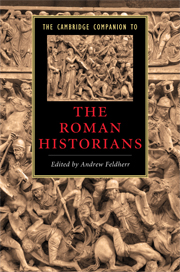Book contents
- Frontmatter
- Introduction
- Part I Approaches
- Part II Contexts and Traditions
- 4 Alternatives to written history in Republican Rome
- 5 Roman historians and the Greeks: Audiences and models
- 6 Cato’s Origines: The historian and his enemies
- 7 Polybius
- Part III Subjects
- Part IV Modes
- Part V Characters
- Part IV Transformations
- Chronological list of the historians of Rome
- Bibliography
- Index
6 - Cato’s Origines: The historian and his enemies
from Part II - Contexts and Traditions
Published online by Cambridge University Press: 28 November 2010
- Frontmatter
- Introduction
- Part I Approaches
- Part II Contexts and Traditions
- 4 Alternatives to written history in Republican Rome
- 5 Roman historians and the Greeks: Audiences and models
- 6 Cato’s Origines: The historian and his enemies
- 7 Polybius
- Part III Subjects
- Part IV Modes
- Part V Characters
- Part IV Transformations
- Chronological list of the historians of Rome
- Bibliography
- Index
Summary
A few months before Cato's death a scandal caused a considerable stir in Roman politics: in 150 BCE, the propraetor of Hispania Ulterior (Further Spain), Ser. Sulpicius Galba, after his victory over the Lusitanians, butchered a great number of the enemy and sold off the rest into slavery, even though they had surrendered and he had guaranteed them clemency. The provincial governor's rashness created such outrage in the capital (not otherwise known for its excessive sensitivity) that the plebeian tribune L. Scribonius Libo proposed a law to free the surviving Lusitanians and court-martial Galba. The proposal polarized politics at Rome with prominent men on both sides. Even Cato, now over eighty years old, stepped once more into the ring with all the vehemence at his disposal. He began his fiery tirade against Galba in the style of the elder Appius Claudius Caecus crusading against peace negotiations with Pyrrhus: “Many things have dissuaded me from appearing here, my years, my time of life, my voice, my strength, my old age; but nevertheless, when I reflected that so important a matter was being discussed . . .” Cato did not succeed: Libo's proposal was finally defeated by a dramatic vote of the popular assembly.
- Type
- Chapter
- Information
- The Cambridge Companion to the Roman Historians , pp. 108 - 122Publisher: Cambridge University PressPrint publication year: 2009
- 9
- Cited by

